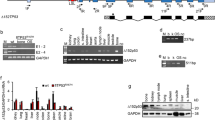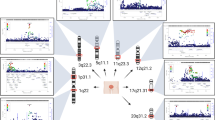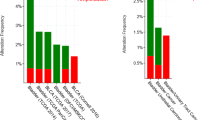Abstract
Deleted in bladder cancer 1 (DBC1) is a tumour suppressor which is involved in the regulation of cell growth and programmed cell death. In this study we report the cloning and characterization of porcine DBC1 cDNA. RT-PCR cloning produced a cDNA with an open reading frame of 2,283 bp encoding a polypeptide of 761 amino acids with a predicted molecular mass of 88.6 kDa and estimated isoelectric point of 9.1. The encoded pig DBC1 protein shows a very high amino acid similarity to human (99 %) and to mouse (98 %) DBC1. The porcine DBC1 gene was mapped to chromosome 1. The nucleotide sequence of the promoter displayed a high degree of conservation of elements responsible for neuron-specific expression. The porcine DBC1 gene was found to be highly expressed in brain tissues. The methylation status of the porcine DBC1 gene was examined in brain and liver by bisulfite sequencing. Methylation percentages of 53–61 were observed for the gene body whereas significantly lower values (1–4 %) were found in exon 1 and the promoter sequence of DBC1. The sequences of the porcine DBC1 cDNA and the DBC1 promoter and exon 1 sequence have been submitted to DDBJ/EMBL/GenBank under the accession numbers KF733442 and KJ396193, respectively.





Similar content being viewed by others
References
Smeets W, Pauwels R, Laarakkers L, Debruyne F, Geraedts J (1987) Chromosomal analysis of bladder cancer III. Non random alterations. Cancer Genet Cytogenet 29:29–41
Olumi AF, Tsai YC, Nichols PW, Skinner DG, Cain DR, Bender LI, Jones PA (1990) Allelic loss of chromosome 17p distinguishes high grade from low grade transitional cell carcinomas of the bladder. Cancer Res 50:7081–7083
Habuchi T, Ogawa O, Kakehi Y, Ogura K, Koshiba M, Hamazaki S, Takahashi R, Sugiyama T, Yoshida O (1993) Accumulated allelic losses in the development of invasive urothelial cancer. Int J Cancer 53:579–584
Knowles MA, Elder PA, Williamson M, Cairns JP, Shaw ME, Law MG (1994) Allelotype of human bladder cancer. Cancer Res 54:531–538
Habuchi T, Luscombe M, Elder PA, Knowles MA (1998) Structure and methylation-based silencing of a gene (DBCCR1) within a candidate bladder cancer tumor suppressor region at 9q32–q33. Genomics 48:277–288
Nishiyama H, Hornigold N, Davies AM, Knowles MA (1999) A sequence-ready 840 kb PAC contig spanning the candidate tumor suppressor locus DBC1 on human chromosome 9q32-q33. Genomics 59:335–338
Habuchi T, Takahashi T, Kakinuma H, Wang L, Tsuchiya N, Satoh S, Akao T, Sato K, Ogawa O, Knowles MA, Kato T (2001) Hypermethylation at 9q32–33 tumour suppressor region is age-related in normal urothelium and an early and frequent alteration in bladder cancer. Oncogene 20:531–537
Izumi H, Inoue J, Yokoi S, Hosoda H, Shibata T, Sunamori M, Hirohashi S, Inazawa J, Imoto I (2005) Frequent silencing of DBC1 is by genetic or epigenetic mechanisms in non-small cell lung cancers. Hum Mol Genet 14:997–1007
Beetz C, Brodoehl S, Patt S, Kalff R, Deufel T (2005) Low expression but infrequent genomic loss of the putative tumour suppressor DBCCR1 in astrocytoma. Oncol Rep 13:335–340
Shim UJ, Lee IS, Kang HW, Kim J, Kim WT, Kim IY, Ryu KH, Choi YH, Moon SK, Kim YJ, Yun SJ, Lee SC, Kim WJ (2013) Decreased DBC1 expression is associated with poor prognosis in patients with non-muscle-invasive bladder cancer. Korean J Urol 54:631–637
Wright KO, Messing EM, Reeder JE (2004) DBCCR1 mediates death in cultured bladder tumor cells. Oncogene 23:82–90
Rudd RG, Whitehair JG, Leipold HW (1991) Spindle cell sarcoma in the kidney of a dog. J Am Vet Med Assoc 19:1023
Bjerre D, Madsen LB, Bendixen C, Larsen K (2006) Porcine parkin: molecular cloning of PARK2 cDNA, expression analysis, and identification of a splicing variant. Biochem Biophys Res Commun 347:803–813
Trapnell C, Pachter L, Salzberg SL (2009) TopHat: discovering splice junctions with RNA Seq. Bioinformatics 25:1105–1111
Trapnell C, Williams BA, Pertea G, Mortazavi A, Kwan G, van Baren MJ, Salzberg SL, Wold BJ, Pachter L (2010) Transcript assembly and quantification by RNA-Seq reveals unannotated transcripts and isoform switching during cell differentiation. Nat Biotechnol 28:511–515
Li H (2011) Tabix: fast retrieval of sequence features from generic TAB-delimited files. Bioinformatics 27:718–719
Kozak M (1987) An analysis of 5′-noncoding sequences from 699 vertebrate messenger RNAs. Nucl Acids Res 15:8125–8148
Kozak M (1991) Structural features in eukaryotic mRNAs that modulate the initiation of translation. J Biol Chem 266:19867–19870
Groenen MA, Archibald AL, Uenishi H, Tuggle CK et al (2012) Analyses of pig genomes provide insight into porcine demography and evolution. Nature 491:393–398
Habuchi T, Yoshida O, Knowles MA (1997) A novel candidate tumour suppressor locus at 9q32–33 in bladder cancer: localization of the candidate region within a single 840 kb YAC. Hum Mol Genet 6:913–919
Su AI, Wiltshire T, Batalov S, Lapp H, Ching KA, Block D, Zhang J, Soden R, Hayakawa M, Kreiman G, Cooke MP, Walker JR, Hogenesch JB (2004) A gene atlas of the mouse and human protein-encoding transcriptomes. Proc Natl Acad Sci USA 101:6062–6067
Grønbaek K, Ralfkiaer U, Dahl C, Hother C, Burns JS, Kassem M, Worm J, Ralfkiaer EM, Knudsen LM, Hokland P, Guldberg P (2008) Frequent hypermethylation of DBC1 in malignant lymphoproliferative neoplasms. Mod Pathol 21:632–638
Kawano H, Nakatani T, Mori T, Ueno S, Fukaya M, Abe A, Kobayashi M, Toda F, Watanabe M, Matsuoka I (2004) Identification and characterization of novel developmentally regulated neural-specific proteins, BRINP family. Brain Res Mol Brain Res 125:60–75
Terashima M, Kobayashi M, Motomiya M, Inoue N, Yoshida T, Okano H, Iwasaki N, Minami A, Matsuoka I (2010) Analysis of the expression and function of BRINP family genes during neuronal differentiation in mouse embryonic stem cell-derived neural stem cells. J Neurosci Res 88:1387–1393
Motomiya M, Kobayashi M, Iwasaki N, Minami A, Matsuoka I (2007) Activity-dependent regulation of BRINP family genes. Biochem Biophys Res Commun 352:623–629
Kobayashi M, Nakatani T, Koda T, Matsumoto K, Ozaki R, Mochida N, Takao K, Miyakawa T, Matsuoka I (2014) Absence of BRINP1 in mice causes increase of hippocampal neurogenesis and behavioral alterations relevant to human psychiatric disorders. Mol Brain 7:12
Nielsen M, Hansen JH, Hedegaard J, Nielsen RO, Panitz F, Bendixen C, Thomsen B (2010) MicroRNA identity and abundance in porcine skeletal muscles determined by deep sequencing. Anim Genet 41:159–168
Du ZQ, Vincent-Naulleau S, Gilbert H, Vignoles F, Créchet F, Shimogiri T, Yasue H, Leplat JJ, Bouet S, Gruand J, Horak V, Milan D, Le Roy P, Geffrotin C (2007) Detection of novel quantitative trait loci for cutaneous melanoma by genome-wide scan in the MeLiM swine model. Int J Cancer 120:303–320
Yamakawa H, Nagai T, Harasawa R, Yamagami T, Takahashi J, Ishikawa K, Nomura N, Nagashima H (1999) Production of transgenic pig carrying MMTV/v-Ha-ras. J Reprod Dev 45:111–118
Adam SJ, Counter CM (2008) A method to generate genetically defined tumors in pigs. Methods Enzymol 439:39–51
Kragh PM, Nielsen AL, Li J, Du Y, Lin L, Schmidt M, Bøgh IB, Holm IE, Jakobsen JE, Johansen MG, Purup S, Bolund L, Vajta G, Jørgensen AL (2009) Hemizygous minipigs produced by random gene insertion and handmade cloning express the Alzheimer’s disease-causing dominant mutation APPsw. Transgenic Res 18:545–558
Yang D, Wang CE, Zhao B, Li W, Ouyang Z, Liu Z, Yang H, Fan P, O’Neill A, Gu W, Yi H, Li S, Lai L, Li XJ (2010) Expression of Huntington’s disease protein results in apoptotic neurons in the brains of cloned transgenic pigs. Hum Mol Genet 19:3983–3994
Lorson MA, Spate LD, Samuel MS, Murphy CN, Lorson CL, Prather RS, Wells KD (2011) Disruption of the survival motor neuron (SMN) gene in pigs using ssDNA. Transgenic Res 20:1293–1304
Acknowledgments
The authors wish to thank Connie Jakobsen Juhl and Bente Flügel for excellent technical assistance and Ms. Janne Hansen for critical reading of the manuscript. The work was supported financially by a Grant from the Danish Agency for Science, Technology and Innovation (274-09-0299).
Author information
Authors and Affiliations
Corresponding author
Electronic supplementary material
Below is the link to the electronic supplementary material.
Rights and permissions
About this article
Cite this article
Larsen, K., Momeni, J., Farajzadeh, L. et al. Cloning and characterization of the porcine DBC1 gene encoding deleted in bladder cancer. Mol Biol Rep 42, 383–391 (2015). https://doi.org/10.1007/s11033-014-3779-0
Received:
Accepted:
Published:
Issue Date:
DOI: https://doi.org/10.1007/s11033-014-3779-0




